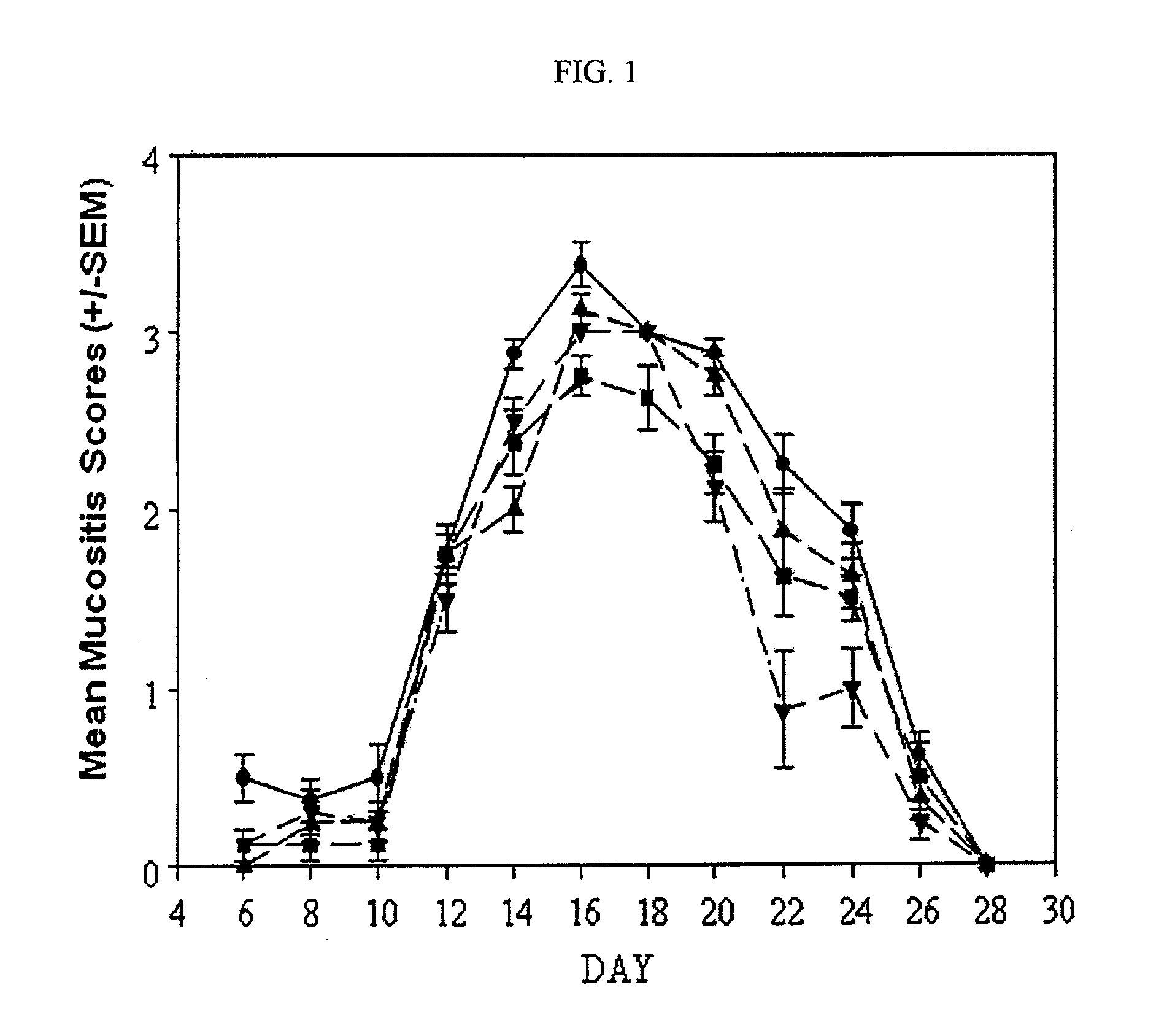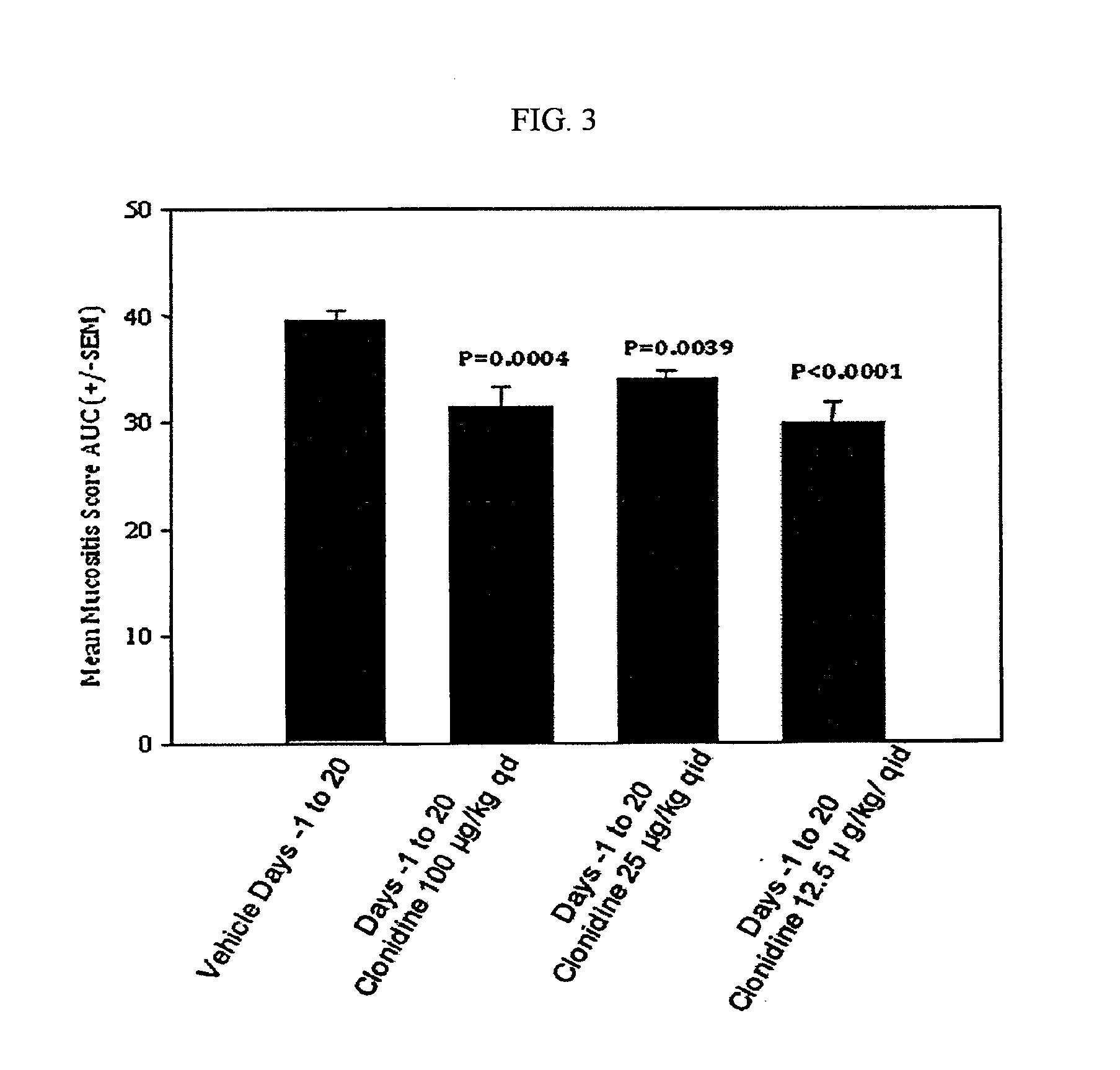Treating inflammation and inflammatory pain in mucosa using mucosal prolonged release bioadhesive therapeutic carriers
a technology of bioadhesive and mucosa, which is applied in the direction of biocide, drug composition, anti-noxious agents, etc., can solve the problems of induced mucosal toxicity, ulcerative lesions, and mucosal mucositis that occurs in the mucosa
- Summary
- Abstract
- Description
- Claims
- Application Information
AI Technical Summary
Benefits of technology
Problems solved by technology
Method used
Image
Examples
example 1
Analysis of Clonidine Anti-Inflammatory Properties in a Human Oral Mucosa Organotypic Culture Model
[0167]I. Study Description
[0168]1—Human Oral Mucosa Organotypic Culture:
[0169]Biopsy samples of clinically healthy non keratinised human oral mucosa were obtained from patients undergoing surgery.
[0170]Small biopsies (explant size: 5 mm2 surface and 3 mm thickness and about 15 to 20 mg weight) were transferred onto permeable polycarbonate membrane transwells (12 mm diameter, 12 μm pore size) in a well of a 12 well plate (as previously described Boisnic S. et al., 2003 and 2006) containing 700 μl of defined medium (DMEM, antibiotics, hormones, pituitary extract, SVF). For each donor, the gingival biopsy was cut to obtain the same weight so that to have comparison between different conditions tested. Explants were maintained at the interface between air and medium: the oral mucosa epithelium was in contact with air and the chorion was exposed to the media by diffusion through the porous ...
example 2
Testing of Clonidine Aqueous Formulation for Preventing and / or Treating Mucositis in Hamsters
[0198]I. Study Protocol
1—Study Summary
[0199]A dose-ranging study was performed using an aqueous formulation of clonidine to demonstrate activity of the agent as an effective modulator of mucositis severity and duration.
[0200]Thirty-two (32) male Syrian Golden Hamsters were randomly assigned to four (4) equally-sized groups. One group served as a saline treated control, and the remaining three received clonidine in different concentrations and / or dosing frequency. All agents were administered topically. On study day 0, each hamster was irradiated with a single dose of 40 Gy directed to the left buccal cheek pouch. Animals were subsequently weighed and observed daily. Beginning on day 6 and continuing on alternate days for the duration of the study, images of the left cheek pouch mucosa was obtained. At the conclusion of the in-life phase of the study, the images were scored for mucositis seve...
example 3
Process 1: Preparation of a Bioadhesive Tablet Containing 0.1 mg Clonidine
[0220]Basically 0.1 mg (base equivalent) of clonidine hydrochloride was blended with 13 mg of calcium phosphate dibasic, with 15 mg of microcrystalline cellulose, with 40 mg of hydroxypropyl methyl cellulose, 1 mg of colloidal silica and 0.9 mg of magnesium stearate.
[0221]The mixture was then homogenized by sieving and 30 mg of milk protein concentrate is added and mixed with the initial mixture. The resulting composition is then compressed under sufficient pressure to form a tablet.
TABLE 4in mg / tablet%Clonidine Hydrochloride0.1*0.1*Calcium phosphate dibasic1313Microcrystalline cellulose1515Hydroxypropyl methyl4040celluloseMilk protein concentrate3030Colloidal silica11Magnesium stearate0.90.9Total100100
Process 2: Preparation of a Bioadhesive Tablet Containing 0.05 mg and 0.1 mg (Base Equivalent) of Clonidine Hydrochloride:
[0222]An aqueous solution of Clonidine Hydrochloride was sprayed on a mixture composed of...
PUM
| Property | Measurement | Unit |
|---|---|---|
| glass transition temperature | aaaaa | aaaaa |
| time | aaaaa | aaaaa |
| time | aaaaa | aaaaa |
Abstract
Description
Claims
Application Information
 Login to View More
Login to View More - R&D
- Intellectual Property
- Life Sciences
- Materials
- Tech Scout
- Unparalleled Data Quality
- Higher Quality Content
- 60% Fewer Hallucinations
Browse by: Latest US Patents, China's latest patents, Technical Efficacy Thesaurus, Application Domain, Technology Topic, Popular Technical Reports.
© 2025 PatSnap. All rights reserved.Legal|Privacy policy|Modern Slavery Act Transparency Statement|Sitemap|About US| Contact US: help@patsnap.com



